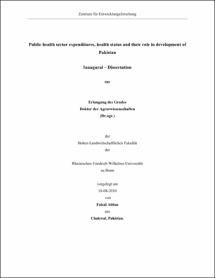Public health sector expenditures, health status and their role in development of Pakistan

Public health sector expenditures, health status and their role in development of Pakistan

| dc.contributor.advisor | Hiemenz, Ulrich | |
| dc.contributor.author | Abbas, Faisal | |
| dc.date.accessioned | 2020-04-14T10:02:43Z | |
| dc.date.available | 2020-04-14T10:02:43Z | |
| dc.date.issued | 21.12.2010 | |
| dc.identifier.uri | https://hdl.handle.net/20.500.11811/4236 | |
| dc.description.abstract | Health is one of the basic capabilities that generate economic freedom. Better health status is described as an indicator of economic success and failure of the nations. The availability of health care services and the physical, biological, epidemiological and socio economic environment in which a person live, broadly determines disease pattern, health status and therefore the quality of life. Despite of economic improvement, social and demographic indicators in Pakistan presents a dismal picture. Nevertheless, Pakistan still has one of the highest infant mortality rates and low (female) life expectancy compared with the other developing countries of comparable income level. Keeping in view the likely role that health can play this dissertation aims at empirically estimating the health related variables and their impact on economic development of Pakistan. This dissertation also aims at empirically estimating the role of different macroeconomic and policy relevant factors affecting public health spending and health status improvements in Pakistan over time. Also, an attempt has been made to see the likely impact of health related variables like health status and per capita calorie availability on economic development using mainly health demand function and health production function approach. This dissertation used time series data of Pakistan from 1972 to 2008. Employing Johansen cointegration methodology, long run income elasticity of health expenditures in Pakistan, is estimated. Contrary to the estimates for most of the industrialized countries, income elasticity of public health expenditures in Pakistan is less than unity while the short run elasticity is even negative. Unemployment and urbanization has a strong negative impact on health expenditures in the long run but urbanization is not significant in short run. Furthermore, using cointegration and Granger bivariate causality analysis for health status of the population it is estimates that per capita health expenditures are negatively related with infant mortality rate and positively related with female life expectancy. An interesting result is reinforcing relationship between fertility and mortality rate in Pakistan verifying the modern economic theory of population. The curative measure of health care system that is doctor population ratio is important factor affecting positively to the female life expectancy and negatively to infant mortality. Another modeling strategy efficiency wage hypothesis is tested using production function framework. The results of nutrition availability are compared with that of life expectancy, fertility, health expenditures and mortality. It is estimated that the magnitude of calorie availability is stronger on per capita income relative to life expectancy, infant mortality, public health expenditures and fertility. One way causality is running from per capita calorie availability to per capita income. It is concluded, based on these important results, that health sector is interlinked with socio-economic development therefore health policy must not see the health services in isolation but in an integrated manner to achieve the broader goals of poverty reduction, human capital formation and economic development. The results support the hypothesis of increasing public investments in health. The role of nutrition in agrarian economy like Pakistan is robust. Government has to ensure the smooth supply of food and nutrition to the population for increasing their living standard and productivity. Policies that increases gender equality as well as promote social inclusion by increasing employment will help in improving health status of the population. | en |
| dc.language.iso | eng | |
| dc.rights | In Copyright | |
| dc.rights.uri | http://rightsstatements.org/vocab/InC/1.0/ | |
| dc.subject | Gesundheitswesen | |
| dc.subject | Gesundheitskosten | |
| dc.subject | Gesundheitszustand | |
| dc.subject | Kointegration | |
| dc.subject | Ursächlichkeit | |
| dc.subject | Ernährung | |
| dc.subject | wirtschaftliche Entwicklung | |
| dc.subject | Pakistan | |
| dc.subject | public health | |
| dc.subject | health expenditures | |
| dc.subject | health status | |
| dc.subject | cointegration | |
| dc.subject | causality | |
| dc.subject | Nutrition | |
| dc.subject | economic development | |
| dc.subject.ddc | 300 Sozialwissenschaften, Soziologie, Anthropologie | |
| dc.subject.ddc | 330 Wirtschaft | |
| dc.title | Public health sector expenditures, health status and their role in development of Pakistan | |
| dc.type | Dissertation oder Habilitation | |
| dc.publisher.name | Universitäts- und Landesbibliothek Bonn | |
| dc.publisher.location | Bonn | |
| dc.rights.accessRights | openAccess | |
| dc.identifier.urn | https://nbn-resolving.org/urn:nbn:de:hbz:5N-23823 | |
| dc.relation.isbn | 978-3-86955-592-8 | |
| ulbbn.pubtype | Erstveröffentlichung | |
| ulbbnediss.affiliation.name | Rheinische Friedrich-Wilhelms-Universität Bonn | |
| ulbbnediss.affiliation.location | Bonn | |
| ulbbnediss.thesis.level | Dissertation | |
| ulbbnediss.dissID | 2382 | |
| ulbbnediss.date.accepted | 29.11.2010 | |
| ulbbnediss.fakultaet | Landwirtschaftliche Fakultät | |
| dc.contributor.coReferee | Heckelei, Thomas |
Files in this item
This item appears in the following Collection(s)
-
E-Dissertationen (1127)







